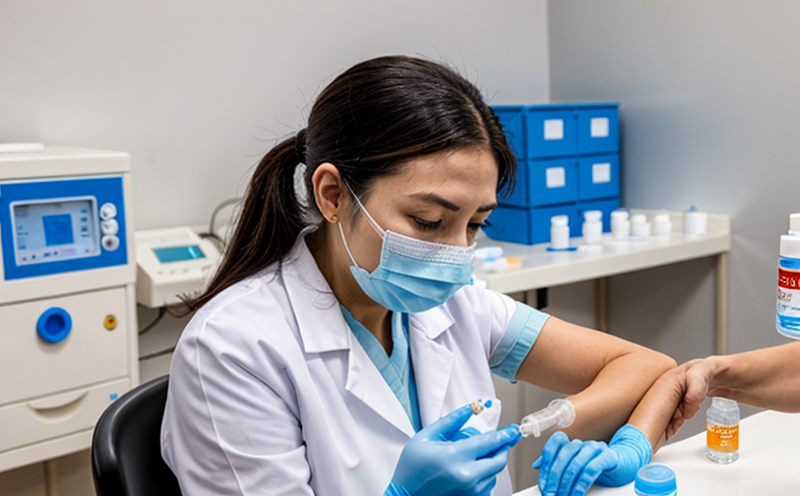USP Osmolality Testing of Vaccine Solutions
The United States Pharmacopeia (USP) Osmolality Test is a critical procedure used to ensure that vaccine solutions comply with the standards set forth by USP. This test evaluates the osmolality, or concentration of particles in solution, which is essential for maintaining the stability and efficacy of vaccines. Vaccine formulations are complex mixtures designed to elicit an immune response without causing adverse effects. Therefore, accurate measurements of osmolality ensure that these solutions function as intended.
Understanding osmolality begins with recognizing how solutes affect the environment around them. When solutes dissolve in a solvent like water, they create a solution where the concentration of particles determines its osmotic properties. Osmolality quantifies this by measuring the number of osmotically active particles per kilogram of solvent. For vaccines, maintaining correct osmolality ensures that the formulation is neither too concentrated nor too dilute, which can impact stability and efficacy.
The USP specifies strict guidelines for osmolality testing to ensure consistency across different formulations. This includes defining acceptable ranges based on the specific vaccine or biological product being tested. For instance, a deviation in osmolality from the target value could lead to instability issues such as precipitation or altered solubility of active ingredients. These changes can compromise the effectiveness of vaccines and potentially impact patient safety.
The process of conducting an USP Osmolality Test involves several key steps:
- Sample preparation: Ensuring that the vaccine solution is free from particulates and properly diluted to the appropriate concentration.
- Solution equilibration: Allowing the test sample to reach osmotic equilibrium with a standard reference solution.
- Instrumentation: Utilizing specialized equipment such as an osmometer designed to measure the freezing point depression or vapor pressure of the solutions.
- Data interpretation: Comparing measured values against USP standards and determining compliance.
The significance of this test cannot be overstated, especially in the context of pharmaceutical quality assurance. By adhering to these stringent protocols, laboratories can ensure that vaccines meet not only regulatory requirements but also the high expectations set by healthcare providers and patients alike.
In summary, USP Osmolality Testing is a cornerstone of vaccine development and manufacturing processes. Its role extends beyond mere compliance with regulations; it serves as a critical quality assurance measure that guarantees the integrity and reliability of vaccines. Understanding these nuances helps stakeholders appreciate why this test is indispensable in safeguarding public health.
Why It Matters
The importance of USP Osmolality Testing cannot be overstated, particularly within the pharmaceutical industry where precision and consistency are paramount. Compliance with regulatory standards like those set by the USP ensures that vaccines perform as expected under various conditions. Non-compliance can lead to significant issues such as reduced efficacy or increased risk for adverse reactions.
From a manufacturing perspective, consistent osmolality in vaccine solutions is crucial for several reasons:
- Product Stability: Proper osmolality helps maintain the physical and chemical stability of vaccines. Deviations can lead to instability factors that affect shelf life and potency.
- Patient Safety: Ensuring correct osmolality prevents potential side effects associated with formulations that are either too concentrated or too dilute.
- Efficacy: Maintaining the intended formulation enhances the overall effectiveness of vaccines, contributing to better health outcomes for patients.
The broader implications extend beyond individual products. Consistent adherence to these standards fosters trust among regulatory bodies and healthcare professionals who rely on reliable data when recommending or administering vaccines. This trust is essential for public confidence in pharmaceutical products.
In summary, the USP Osmolality Test plays a vital role in maintaining the integrity of vaccine solutions. By upholding these stringent protocols, laboratories contribute to safer, more effective medical treatments that ultimately benefit society as a whole.
Industry Applications
The application of USP Osmolality Testing is not limited to just one type of product or environment; it spans across various sectors within the pharmaceutical industry. This versatility makes it an indispensable tool for ensuring quality and safety in diverse areas.
- Vaccine Manufacturing: Ensuring that vaccine solutions meet osmotic requirements helps maintain their stability and efficacy throughout production and storage.
- Biotherapeutic Production: For biologics, proper osmolality ensures optimal conditions for cell culture and subsequent purification steps.
- In Vitro Diagnostic Devices (IVD): In the realm of diagnostics, maintaining correct osmolality can affect the performance of reagents used in assays.
- Drug Delivery Systems: The accuracy of osmolality testing is critical for ensuring that drug delivery systems function correctly under varied conditions.
Beyond these specific applications, the broader impact lies in fostering an environment where quality assurance practices are integral to every stage of product development. This approach not only enhances reliability but also promotes innovation by allowing researchers and manufacturers to explore new formulations safely and effectively.
By embracing USP Osmolality Testing as a standard practice across industries, we can ensure that our healthcare products continue to meet the highest standards of safety and efficacy.
Use Cases and Application Examples
- Vaccine Stability Studies: During early-stage development, osmolality testing helps identify potential stability issues before large-scale production begins.
- Formulation Optimization: Adjustments can be made based on osmolality results to improve the overall quality of vaccine formulations.
- Manufacturing Quality Control: Regular testing ensures that each batch produced meets strict standards, reducing variability and enhancing consistency.
- Storage Conditions: Testing allows for understanding how different storage conditions affect osmolality over time, informing optimal packaging and labeling recommendations.
- Adverse Event Analysis: Post-marketing surveillance can use this data to correlate osmolality with reported side effects or efficacy issues.
- Licensing and Approval Processes: Regulatory bodies often require these tests as part of the approval process, ensuring compliance before a vaccine can be marketed.
- Supply Chain Management: Consistency in osmolality across batches helps streamline supply chain operations by minimizing discrepancies between lots.
These examples illustrate how USP Osmolality Testing is integral to various stages of the pharmaceutical lifecycle, from research and development through manufacturing and distribution. Its role underscores its importance as a fundamental quality assurance measure that contributes significantly to patient care and public health.





